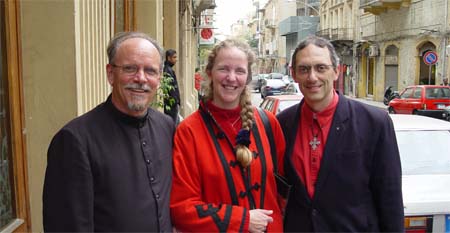
Wednesday, March 8, Fr. Krikor and I join Sarah and Fr. Nabil Shehadi for Lebanese mezze (a variety of side dishes and dips — hors d’oeuvres, really, but more than enough for a tasty lunch.) Fr. Nabil and Fr. Krikor negotiate most of the menu, and its all wonderful — topped off with a nice cup of “café blanc” — nothing to do with café (other than it too comes in a cup), a hot clear drink, a Lebanese specialty, made from rose water … quite delicious too.
Following lunch, Fr. Krikor goes his way — he has an afternoon class to
teach, and I join the Shehadis to explore the Mar Nicholas neighbourhood, a short walk from Martyrs’ Square.
First stop on our way is a small lamp boutique that Sarah has found — the
Shehadis, new to Lebanon, are still putting the final touches to their apartment
and a ceiling lamp for their living room is on the list of things to find. Nasri
Dekmak, pictured here with his wife, is a “maître artisant de lustres” (master
lamp craftsman) and it seems that he is a not too distant cousin of Fr. Nabil’s
— Sarah tells me that this sort of thing
the Mar Nicholas neighbourhood, a short walk from Martyrs’ Square.
First stop on our way is a small lamp boutique that Sarah has found — the
Shehadis, new to Lebanon, are still putting the final touches to their apartment
and a ceiling lamp for their living room is on the list of things to find. Nasri
Dekmak, pictured here with his wife, is a “maître artisant de lustres” (master
lamp craftsman) and it seems that he is a not too distant cousin of Fr. Nabil’s
— Sarah tells me that this sort of thing discovering a cousin, happens all the time — Lebanon is just that
small a country that any two of its natives are often related, rather like
Quebec I suppose. Monsieur Dekmak takes us up a side street to visit his
workshop, which we discover is something of the Ali Baba’ cave of chandeliers
and hanging lamps. Lots of ideas for the Shehadis to consider! Monsieur directs
us up the Mar Nicholas stairway to see one of the chandeliers he has made,
hanging in a small gallery along the stairway.
discovering a cousin, happens all the time — Lebanon is just that
small a country that any two of its natives are often related, rather like
Quebec I suppose. Monsieur Dekmak takes us up a side street to visit his
workshop, which we discover is something of the Ali Baba’ cave of chandeliers
and hanging lamps. Lots of ideas for the Shehadis to consider! Monsieur directs
us up the Mar Nicholas stairway to see one of the chandeliers he has made,
hanging in a small gallery along the stairway.
After visiting the gallery, we continue up the stairs to rue Sursock and some of the finest old homes in Beirut.
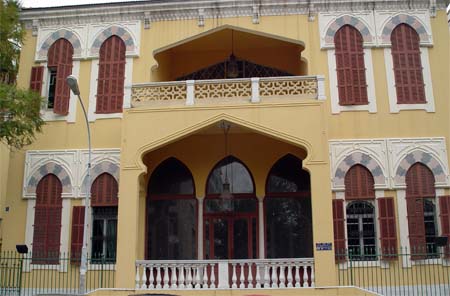
Fr. Nabil, an architect by training, explains that the three central window
bays in the facade pictured here, open into an interiour court or large
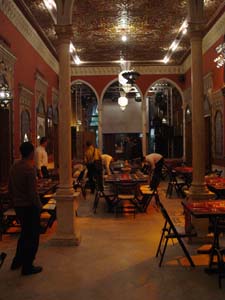 central room designed to capture the sea
breezes, cooling off the rooms along either side of the court. Nokia has rented
the central court of the home pictured above for a sales event, and we take the
liberty of looking inside as workers busy themselves with preparations for the
fête.
central room designed to capture the sea
breezes, cooling off the rooms along either side of the court. Nokia has rented
the central court of the home pictured above for a sales event, and we take the
liberty of looking inside as workers busy themselves with preparations for the
fête.
This open design is comon to many of the houses we see in our exploration of the neighbourhood. The homes are in various stages of decay or refurbishment, some have businesses on the main floor, others (as you will see later on) have been transformed into museums or other public spaces.
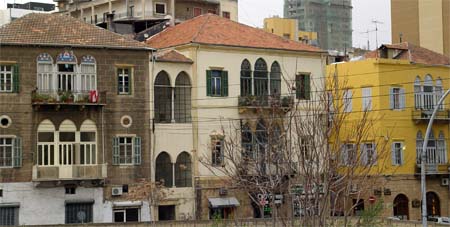
As we wander through the neighbourhood we find the fellow, picture right,
busy dusting his car. 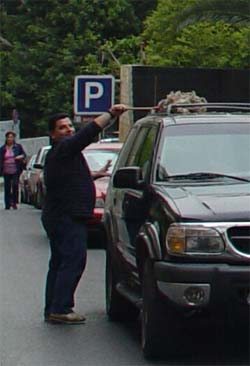 In Quebec City,
it is “de rigeur” that every automobile be equiped with a snow brush and ice
scraper. In Beirut, a dust brush is required because of the occasional sand
storms that blow in from the Sahara (particularly in the spring, it seems)
covering the entire country with a coat of fine dust. I’m told that the weather
in March is predictably unpredictable: warm and sunny (the month certainly came
in like a lamb!), to cold and windy, and the occasional sand storm thrown in
just to make things interesting. I report that it has warmed up to -3C in Quebec
City, and the Lebanese respond with a shiver!
In Quebec City,
it is “de rigeur” that every automobile be equiped with a snow brush and ice
scraper. In Beirut, a dust brush is required because of the occasional sand
storms that blow in from the Sahara (particularly in the spring, it seems)
covering the entire country with a coat of fine dust. I’m told that the weather
in March is predictably unpredictable: warm and sunny (the month certainly came
in like a lamb!), to cold and windy, and the occasional sand storm thrown in
just to make things interesting. I report that it has warmed up to -3C in Quebec
City, and the Lebanese respond with a shiver!
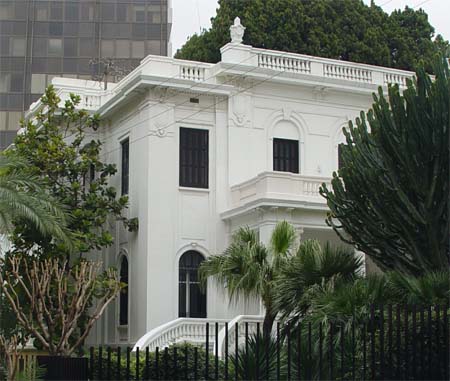
Next stop along the way, a marvelous 19th century mansion, designed in
something of a Georgian style (if the 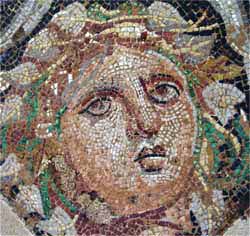 term “Georgian” can be applied in Lebanon!) and now owned by the
Audis, a prominent Lebanese family from Sidon. The mansion once served as the
head office for the Audi Bank, the very friendly caretaker tells us, but it is
now being converted into a museum to house the Audi family’s extensive
collection of Byzantine mosaics, for the most part from ruins around the city of
Sidon. These would have graced the floors and walls of buildings like those, now
in ruins, that Fr. Krikor and I visited in Tyre’s Al-Bass archeological park
(see “Never Tyre of Sidon” posted below).
term “Georgian” can be applied in Lebanon!) and now owned by the
Audis, a prominent Lebanese family from Sidon. The mansion once served as the
head office for the Audi Bank, the very friendly caretaker tells us, but it is
now being converted into a museum to house the Audi family’s extensive
collection of Byzantine mosaics, for the most part from ruins around the city of
Sidon. These would have graced the floors and walls of buildings like those, now
in ruins, that Fr. Krikor and I visited in Tyre’s Al-Bass archeological park
(see “Never Tyre of Sidon” posted below).
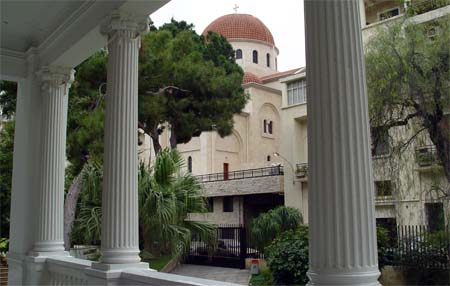
From the front steps of the Audi mansion, we see the namesake of the
neighbourhood, Greek Orthodox chuch of Mar Nicholas (St. Nicholas). Our first
impression is that the church is closed, and we won’t get an opportunity to look
inside. Our persistence, however, is rewarded, and we discover an open side door
in the back of the building, leading into the lower level where the church halls
and the original Mar Nicholas chapel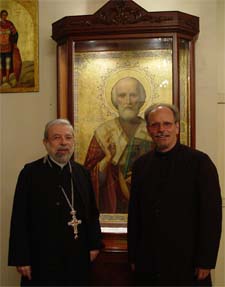 are located.
are located.
Peaking through one door, I find a Greek Orthodox priest, Archimandrite Alexis Moufarrege, in the sacristy, who extends a very warm invitation to come in and have a look around. (Fr. Nabil is convinced that my cassock — which I wear because it is orthodox custom to do so — works like a kind of laisser-passer, and muses that he might start wearing his own cassock when exploring Beirut!)
Pleading the approach of sunset, we politely refuse the archimandrite’s kind offer of coffee, tea, or juice and a conversation, but we gladly accept his offer to show us around. We visit the old chapel on the lower floor (the miraculous icon of St. Nicholas, picture above, is in the lower chapel), and the new basilica above with its iconostasis or wall of icons.

The warmth of Archimandrite Moufarrege’s welcome is not unlike the welcome we received at the Maronite Patriarchate, Birkirke (earlier post) and seems emblematic of the traditional Christian communities in Lebanon. Encouraging, indeed!

After our tour of Mar Nicholas Church, we return to Sursock Street to visit
the Musée
Nicholas Sursock, in the old Sursock family mansion. The museum opens at 4
p.m. and we have been looking forward to this visit. Currently, the museum
features a presentation of the project to reinvent the Lebanese “Bibliothèque
Nationale”. The former National Library was located very near the green line,
the line of demarcation between Christian and Moslem Beirut, and for 15 years the “no man’s land” of the civil
war.
15 years the “no man’s land” of the civil
war.
The library’s collection of 200,000 books and periodicals, was stored under very adverse conditions, with the result that the majority of the collection was damaged by water and mildew or stolen by looters. The Sursock Museum is currently hosting an exhibition of paintings by 40 contemporary Lebanese artists, whose work has been offered for sale to help raise funds for the revived library. (I am delighted to learn that the government of Quebec has made a significant — and clearly appreciated — financial contribution to the national library project.) There are also displays of architectural plans for the new library — the former buildings of the Lebanese University Faculty of Law will become the new home for the library. I take particular interest in watching conservators in the endless work of patching and reparing the thousands of damaged books in the library’s collection.
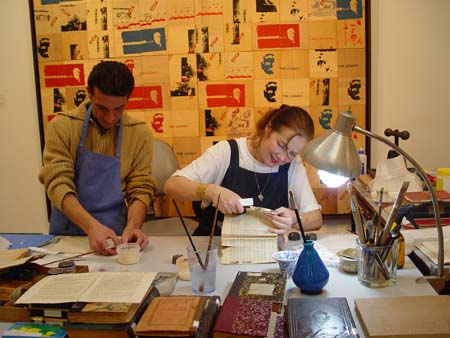
After bidding farewell to Fr. Nabil and Sarah, I make my way by service taxi
and bus back home to the Catholicosate. Service taxis function like tiny buses.
There drivers cruise along the busy
streets, honking their horns to attract the attention of pedestrians standing or
walking along the roadway. I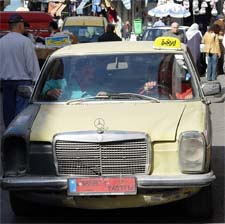 speak to the driver of the cab that pulls up to the
curb where I am standing, and tell him I am headed for Antelias, via the Dora
round-about (knowing that the taxi will likely go no further than Dora, which
may be the new line of demarcation between east and west Beirut, in the world of
Christian and Moslem taxi drivers ??) The driver nods “yes” in a way that is
typically confusing for the non-Lebanese, and agrees to my one raised finger (a
single 1,000LL note — about 80 cents Canadian — will be the fare to Dora). There
is already another passenger in the taxi, but the driver is unsuccessful, and
not for lack of effort, in recruiting passengers for the 3 remaining seats
available (2 more could fit in the back where I am sitting, one more in the
front, between the driver and the other passenger.)
speak to the driver of the cab that pulls up to the
curb where I am standing, and tell him I am headed for Antelias, via the Dora
round-about (knowing that the taxi will likely go no further than Dora, which
may be the new line of demarcation between east and west Beirut, in the world of
Christian and Moslem taxi drivers ??) The driver nods “yes” in a way that is
typically confusing for the non-Lebanese, and agrees to my one raised finger (a
single 1,000LL note — about 80 cents Canadian — will be the fare to Dora). There
is already another passenger in the taxi, but the driver is unsuccessful, and
not for lack of effort, in recruiting passengers for the 3 remaining seats
available (2 more could fit in the back where I am sitting, one more in the
front, between the driver and the other passenger.)
From Dora, I take a privately owned mini-bus (the fare is 750LL or about 60 cents Canadian) to Antelias, and despite the thick traffic (the traffic is always thick here!) I make it back to the Catholicosate in time for supper. Fr. Vaghinag invites me to come and meet his Wednesday night adult Bible study class, to give his students a chance to meet “the Anglican priest from Canada.” I join Fr. Vahinag and his students at 7:30 p.m. for a brief presentation followed by some time for questions.
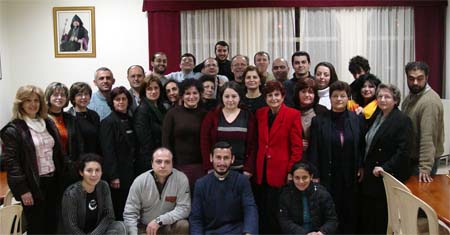
They are a keen group, cleary very fond of Fr. Vaghinag (pictured here, front centre). Today, March 9, is “Teachers’ Day” in Lebanon, so they brought along a couple of cakes in honour of their teacher. They are a cheerful and intelligent group, and some seem already well informed about Anglicanism.
In a pastoral letter sent out yesterday (posted below), the Catholicos invites the Armenian youth “to engage in ecumenical life with … spirit, opennes and vision.” The students like those in Fr. Vaghinag’s class must make the Catholicos very proud!






